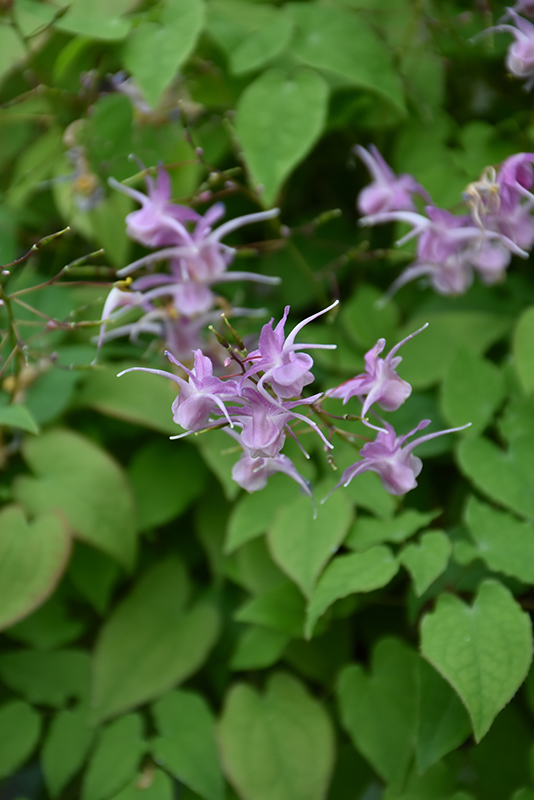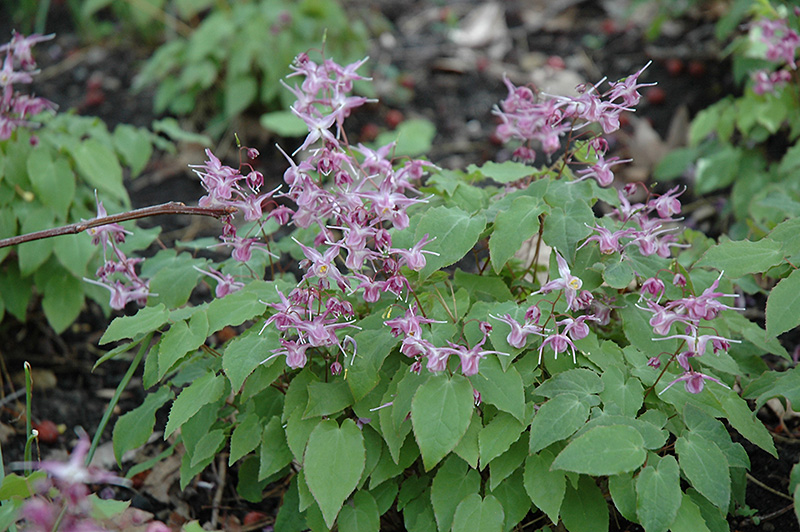>> Home
Lilafee Bishop's Hat
Epimedium grandiflorum 'Lilafee'
Height: 18 inches
Spacing: 15 inches
Sunlight:
![]()
![]()
Hardiness Zone: 5
Other Names: Barrenwort, Bishop's Hat, Fairy Wings
Description:
Delicate shooting star-like lilac flowers, largest of the species; shield-shaped green leaves have reddish mottling in spring and fall; makes a great groundcover that is tolerant of dry shade once established; also grows well in moisture if well-drained
Ornamental Features
Lilafee Bishop's Hat features delicate nodding lilac purple star-shaped flowers with purple spurs rising above the foliage from mid to late spring. Its attractive heart-shaped leaves emerge red in spring, turning green in colour with distinctive antique red edges. As an added bonus, the foliage turns a gorgeous brick red in the fall.
Landscape Attributes
Lilafee Bishop's Hat is a dense herbaceous evergreen perennial with a ground-hugging habit of growth. Its medium texture blends into the garden, but can always be balanced by a couple of finer or coarser plants for an effective composition.
This plant will require occasional maintenance and upkeep, and is best cleaned up in early spring before it resumes active growth for the season. It is a good choice for attracting bees to your yard, but is not particularly attractive to deer who tend to leave it alone in favor of tastier treats. Gardeners should be aware of the following characteristic(s) that may warrant special consideration;
- Spreading
Lilafee Bishop's Hat is recommended for the following landscape applications;
- Mass Planting
- Border Edging
- General Garden Use
- Groundcover
- Naturalizing And Woodland Gardens
- Container Planting
Planting & Growing
Lilafee Bishop's Hat will grow to be about 18 inches tall at maturity, with a spread of 18 inches. When grown in masses or used as a bedding plant, individual plants should be spaced approximately 15 inches apart. Its foliage tends to remain dense right to the ground, not requiring facer plants in front. It grows at a medium rate, and under ideal conditions can be expected to live for approximately 10 years. As an evegreen perennial, this plant will typically keep its form and foliage year-round.
This plant does best in partial shade to shade. It is very adaptable to both dry and moist growing conditions, but will not tolerate any standing water. It is considered to be drought-tolerant, and thus makes an ideal choice for a low-water garden or xeriscape application. It is not particular as to soil pH, but grows best in rich soils. It is somewhat tolerant of urban pollution. Consider applying a thick mulch around the root zone in winter to protect it in exposed locations or colder microclimates. This is a selected variety of a species not originally from North America. It can be propagated by division; however, as a cultivated variety, be aware that it may be subject to certain restrictions or prohibitions on propagation.
Lilafee Bishop's Hat is a fine choice for the garden, but it is also a good selection for planting in outdoor pots and containers. Because of its spreading habit of growth, it is ideally suited for use as a 'spiller' in the 'spiller-thriller-filler' container combination; plant it near the edges where it can spill gracefully over the pot. Note that when growing plants in outdoor containers and baskets, they may require more frequent waterings than they would in the yard or garden.

